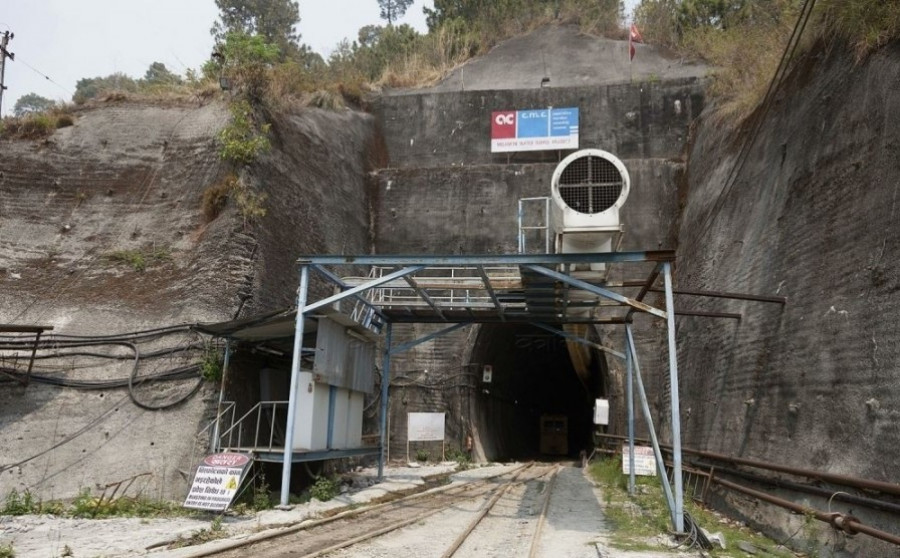Columns
The morass that is Melamchi
The government must hold an inquiry into the tunnel disaster that killed two persons.
Naresh Koirala
In early July, the Ministry of Water Supply announced the start of hydrostatic testing of the Melamchi Water Tunnel. The 27-km-long tunnel was constructed to convey water from the Melamchi River in Nepal's eastern hills to Kathmandu. The test involved filling the main tunnel with water and pressurising it to check for leakage. Upon successful testing, water from Melamchi will start flowing in Kathmandu's taps. Kathmandu was euphoric at the announcement. Then tragedy struck. On July 14, the bulkhead in one of the tunnel's adits—a side entrance to the main tunnel—broke open and the ensuing torrent swept away the members of the technical team monitoring the test. Two of them died. The bulkhead, also called a gate, is supposed to stop the uncontrolled entry of the water in the main tunnel into the adit. That did not happen.
A government investigation concluded that the configuration of the as-built gate did not follow the contract specification. It opened in the adit. The specification required it to open in the main tunnel. The story of the Melamchi Water Tunnel is much bigger than the failure of the gate. The failure is just one of the outcomes of the malaise that has plagued this project since its start.
Story of the tunnel
The story of the Melamchi Water Tunnel is a story of staffing instability, corruption, mismanagement, incompetence, political meddling and lack of leadership. Since 2000, when the first project funding agreement with the Asian Development Bank was signed, the Melamchi Water Tunnel has changed key project personnel at a frequency that has made smooth management of the project virtually impossible. In the last 20 years, the project has had 14 executive chairmen and three tunnelling contractors. More than 10 ministers have passed through the Melamchi Water Tunnel revolving door.
None of the ministers came with qualifications to manage large engineering projects. The first thing they do when they assume office is to replace the executive chairman with one of their trusted lieutenants. This ensures their unquestioned control over the finances of the project. The relationship between the Melamchi Water Tunnel and the tunnelling contractor, regardless of who the contractor happens to be, has been marred by disputes since the beginning of the project. The disputes grow with time and, eventually, the relationship becomes unworkable. The contractor leaves the project, or is fired.
Contractual disputes are common in engineering projects. They are resolved following the process prescribed in the contract. Termination and turnover of contractors during construction, at the rate that happened in the Melamchi Water Tunnel project, rarely happens elsewhere in the world.
The government's explanation for each termination is non-performance by the contractor, but the government vetted each one of these contractors for capacity, similar previous work record and competence as part of the selection process. If the selected contractor did not have a successful record, why was it selected in the first place? If it did have a successful record, what stopped it from performing in Nepal? Why is the relationship between the project owners and the contractors always in trouble? Is there a structural problem in our project procurement and management procedure? Allegations of misappropriation of project funds by rent-seeking politicians and bureaucrats have also been widely reported.
In truth, the contractors are as much a part of the project's problems as the Melamchi Water Tunnel officials. Had they not yielded to the alleged maleficent demands by the officials, the project would probably not have suffered.
Public inquiry
The Melamchi Water Tunnel project is a metaphor for everything that is wrong with Nepal's engineering project management. Due diligence would demand that an independent public inquiry on all aspects of this project be carried out to identify why this six-year project took nearly 20 years to be constructed. The inquiry will identify technical deficiencies and structural constraints that hindered its delivery. It will provide a sound basis for reform required for project delivery within schedule and budget. The gate collapse, on its own, demands an independent inquiry. What are the protocols to approve major re-designs? Were they followed? Why did not the project engineers know, until two young lives were lost, that the configuration of the gate had been changed? Who is accountable for the disaster?
The government of Nepal is unlikely to initiate such an inquiry lest it exposes unwanted truths that the powers that be would prefer to keep under wraps. It is worth remembering that there never was an inquiry after the 2015 earthquake. Regardless, if there is enough public pressure from the engineering community and the Nepal Engineering Council, whose remit is to uphold engineering standards, the government may bow down and do the right thing—launch a probe. The future of Nepal's engineering projects rests with the engineering community.
***
What do you think?
Dear reader, we’d like to hear from you. We regularly publish letters to the editor on contemporary issues or direct responses to something the Post has recently published. Please send your letters to [email protected] with "Letter to the Editor" in the subject line. Please include your name, location, and a contact address so one of our editors can reach out to you.




 10.12°C Kathmandu
10.12°C Kathmandu













%20(1).jpg&w=300&height=200)

